Case Study Reflection: Driscoll's Model in Geriatric Ward Case
VerifiedAdded on 2022/10/06
|7
|2105
|370
Case Study
AI Summary
This case study reflection explores a nursing student's experience in a geriatric ward, focusing on a patient fall incident. The reflection utilizes Driscoll's Model to analyze the event (What?), its impact (So What?), and lessons learned (Now What?). The student describes the scenario, which involved an elderly patient with multiple health issues who fell while attempting to go to the toilet. The analysis highlights the student's initial reaction, the factors contributing to the fall (e.g., bed height, lack of non-slip footwear, and inadequate patient education on the call light), and the importance of incident reporting. The reflection emphasizes the need for improved patient assessment, establishing therapeutic relationships, and effective patient safety interventions. The student identifies areas for improvement, such as enhancing communication skills and undergoing further training on falls prevention strategies, referencing relevant literature to support their conclusions. The case study underscores the critical role of nurses in preventing falls, promoting patient safety, and improving the quality of care in geriatric settings. The assignment also emphasizes the need for nurses to improve their communication and patient education skills.
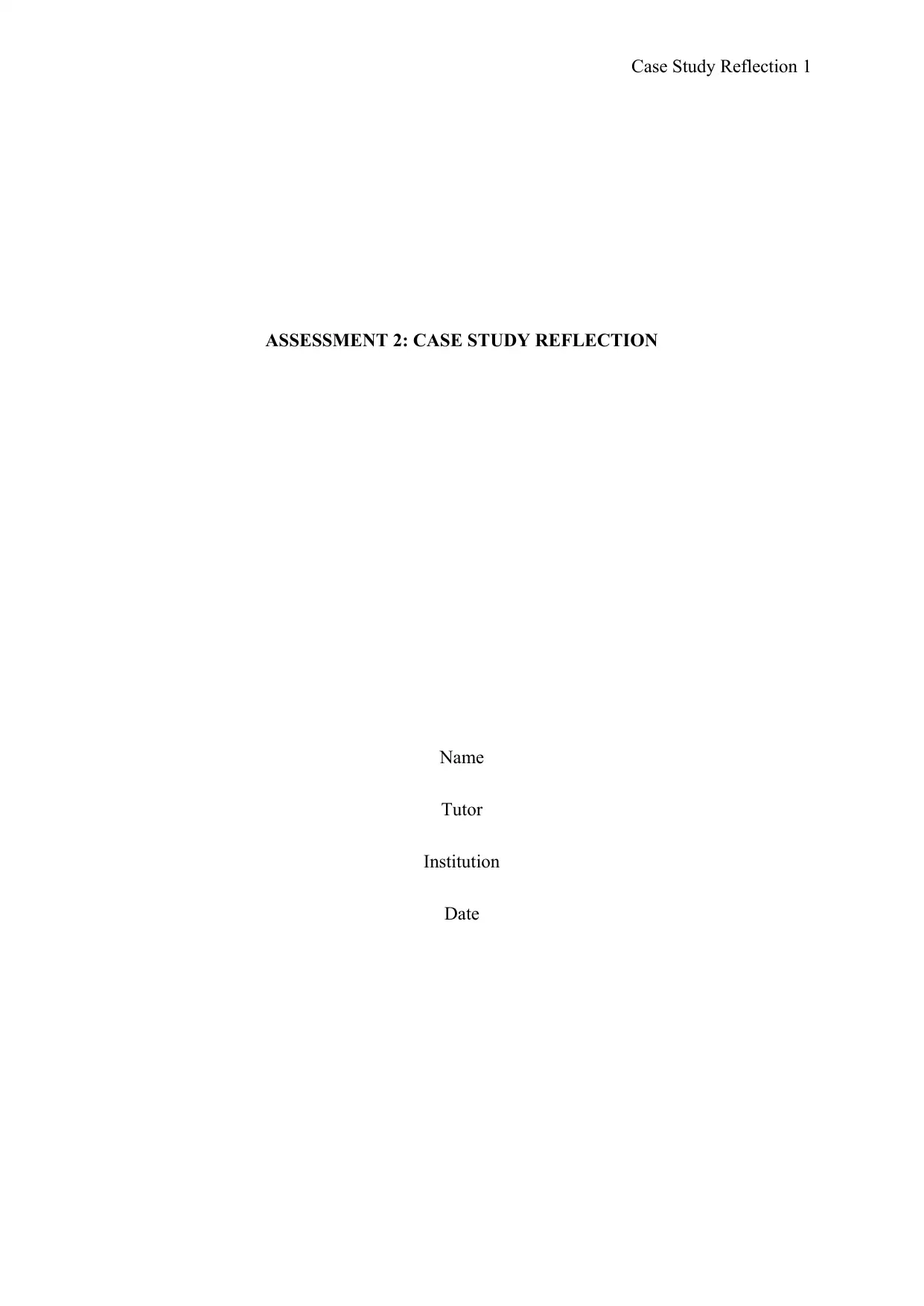
Case Study Reflection 1
ASSESSMENT 2: CASE STUDY REFLECTION
Name
Tutor
Institution
Date
ASSESSMENT 2: CASE STUDY REFLECTION
Name
Tutor
Institution
Date
Paraphrase This Document
Need a fresh take? Get an instant paraphrase of this document with our AI Paraphraser
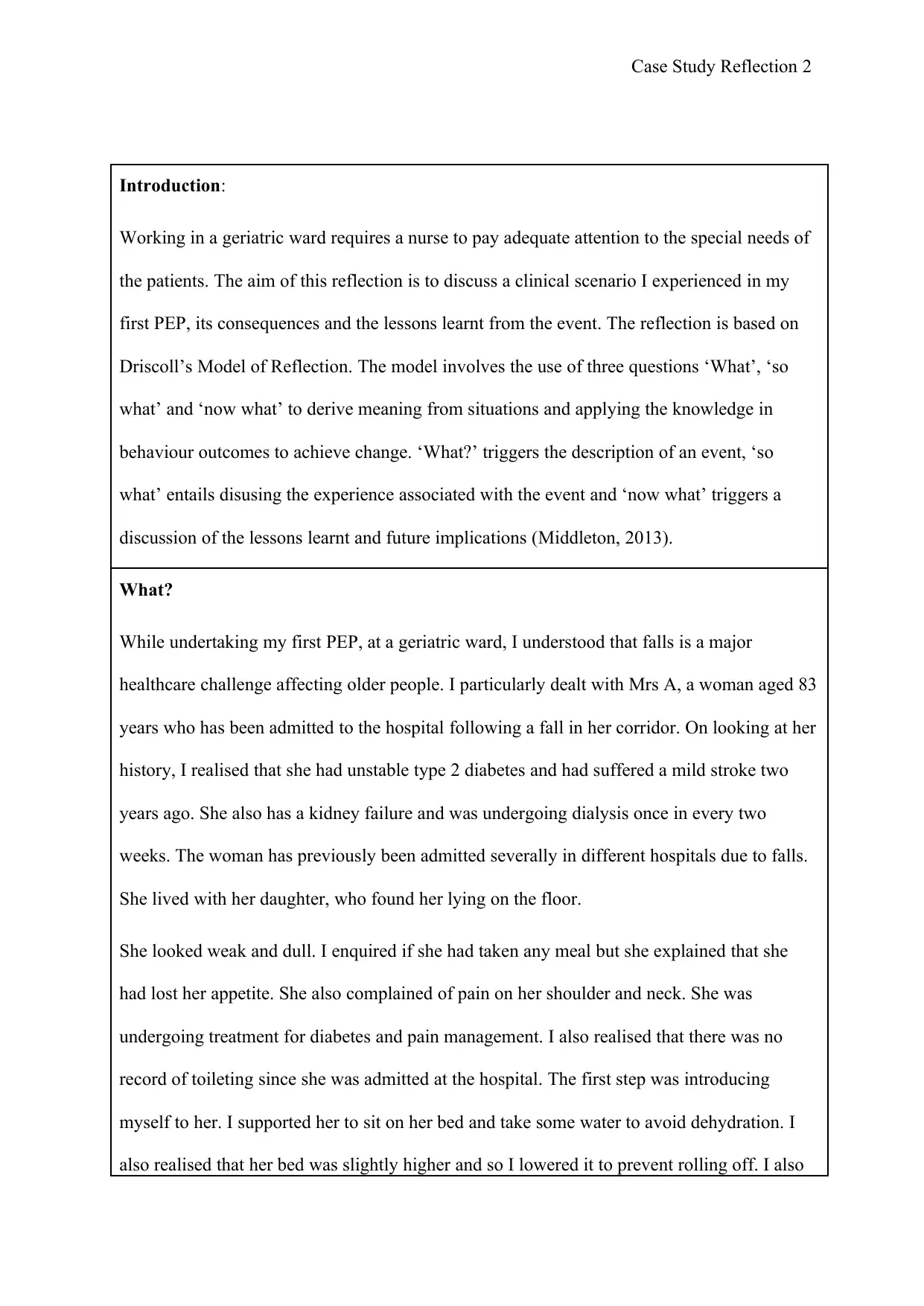
Case Study Reflection 2
Introduction:
Working in a geriatric ward requires a nurse to pay adequate attention to the special needs of
the patients. The aim of this reflection is to discuss a clinical scenario I experienced in my
first PEP, its consequences and the lessons learnt from the event. The reflection is based on
Driscoll’s Model of Reflection. The model involves the use of three questions ‘What’, ‘so
what’ and ‘now what’ to derive meaning from situations and applying the knowledge in
behaviour outcomes to achieve change. ‘What?’ triggers the description of an event, ‘so
what’ entails disusing the experience associated with the event and ‘now what’ triggers a
discussion of the lessons learnt and future implications (Middleton, 2013).
What?
While undertaking my first PEP, at a geriatric ward, I understood that falls is a major
healthcare challenge affecting older people. I particularly dealt with Mrs A, a woman aged 83
years who has been admitted to the hospital following a fall in her corridor. On looking at her
history, I realised that she had unstable type 2 diabetes and had suffered a mild stroke two
years ago. She also has a kidney failure and was undergoing dialysis once in every two
weeks. The woman has previously been admitted severally in different hospitals due to falls.
She lived with her daughter, who found her lying on the floor.
She looked weak and dull. I enquired if she had taken any meal but she explained that she
had lost her appetite. She also complained of pain on her shoulder and neck. She was
undergoing treatment for diabetes and pain management. I also realised that there was no
record of toileting since she was admitted at the hospital. The first step was introducing
myself to her. I supported her to sit on her bed and take some water to avoid dehydration. I
also realised that her bed was slightly higher and so I lowered it to prevent rolling off. I also
Introduction:
Working in a geriatric ward requires a nurse to pay adequate attention to the special needs of
the patients. The aim of this reflection is to discuss a clinical scenario I experienced in my
first PEP, its consequences and the lessons learnt from the event. The reflection is based on
Driscoll’s Model of Reflection. The model involves the use of three questions ‘What’, ‘so
what’ and ‘now what’ to derive meaning from situations and applying the knowledge in
behaviour outcomes to achieve change. ‘What?’ triggers the description of an event, ‘so
what’ entails disusing the experience associated with the event and ‘now what’ triggers a
discussion of the lessons learnt and future implications (Middleton, 2013).
What?
While undertaking my first PEP, at a geriatric ward, I understood that falls is a major
healthcare challenge affecting older people. I particularly dealt with Mrs A, a woman aged 83
years who has been admitted to the hospital following a fall in her corridor. On looking at her
history, I realised that she had unstable type 2 diabetes and had suffered a mild stroke two
years ago. She also has a kidney failure and was undergoing dialysis once in every two
weeks. The woman has previously been admitted severally in different hospitals due to falls.
She lived with her daughter, who found her lying on the floor.
She looked weak and dull. I enquired if she had taken any meal but she explained that she
had lost her appetite. She also complained of pain on her shoulder and neck. She was
undergoing treatment for diabetes and pain management. I also realised that there was no
record of toileting since she was admitted at the hospital. The first step was introducing
myself to her. I supported her to sit on her bed and take some water to avoid dehydration. I
also realised that her bed was slightly higher and so I lowered it to prevent rolling off. I also
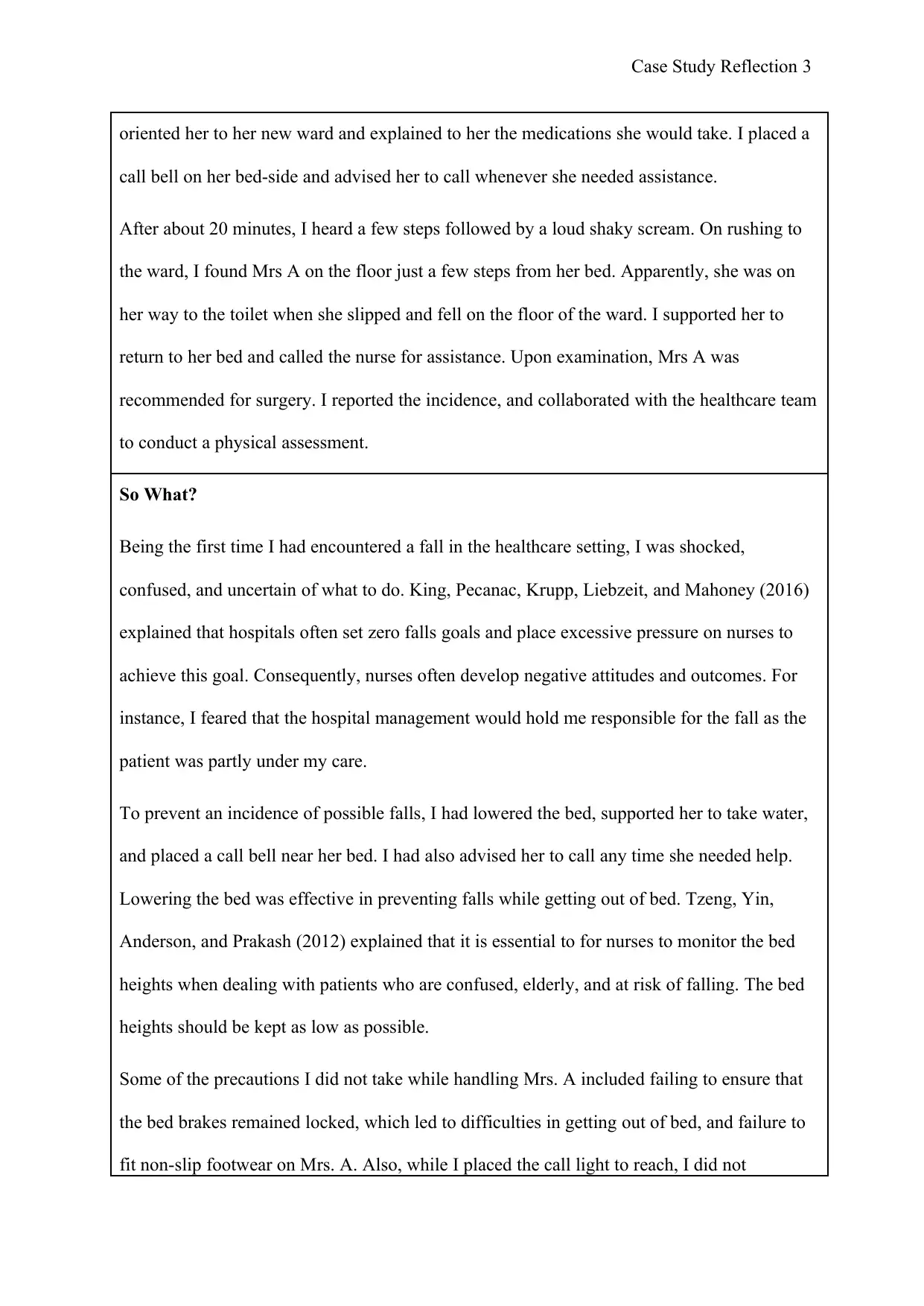
Case Study Reflection 3
oriented her to her new ward and explained to her the medications she would take. I placed a
call bell on her bed-side and advised her to call whenever she needed assistance.
After about 20 minutes, I heard a few steps followed by a loud shaky scream. On rushing to
the ward, I found Mrs A on the floor just a few steps from her bed. Apparently, she was on
her way to the toilet when she slipped and fell on the floor of the ward. I supported her to
return to her bed and called the nurse for assistance. Upon examination, Mrs A was
recommended for surgery. I reported the incidence, and collaborated with the healthcare team
to conduct a physical assessment.
So What?
Being the first time I had encountered a fall in the healthcare setting, I was shocked,
confused, and uncertain of what to do. King, Pecanac, Krupp, Liebzeit, and Mahoney (2016)
explained that hospitals often set zero falls goals and place excessive pressure on nurses to
achieve this goal. Consequently, nurses often develop negative attitudes and outcomes. For
instance, I feared that the hospital management would hold me responsible for the fall as the
patient was partly under my care.
To prevent an incidence of possible falls, I had lowered the bed, supported her to take water,
and placed a call bell near her bed. I had also advised her to call any time she needed help.
Lowering the bed was effective in preventing falls while getting out of bed. Tzeng, Yin,
Anderson, and Prakash (2012) explained that it is essential to for nurses to monitor the bed
heights when dealing with patients who are confused, elderly, and at risk of falling. The bed
heights should be kept as low as possible.
Some of the precautions I did not take while handling Mrs. A included failing to ensure that
the bed brakes remained locked, which led to difficulties in getting out of bed, and failure to
fit non-slip footwear on Mrs. A. Also, while I placed the call light to reach, I did not
oriented her to her new ward and explained to her the medications she would take. I placed a
call bell on her bed-side and advised her to call whenever she needed assistance.
After about 20 minutes, I heard a few steps followed by a loud shaky scream. On rushing to
the ward, I found Mrs A on the floor just a few steps from her bed. Apparently, she was on
her way to the toilet when she slipped and fell on the floor of the ward. I supported her to
return to her bed and called the nurse for assistance. Upon examination, Mrs A was
recommended for surgery. I reported the incidence, and collaborated with the healthcare team
to conduct a physical assessment.
So What?
Being the first time I had encountered a fall in the healthcare setting, I was shocked,
confused, and uncertain of what to do. King, Pecanac, Krupp, Liebzeit, and Mahoney (2016)
explained that hospitals often set zero falls goals and place excessive pressure on nurses to
achieve this goal. Consequently, nurses often develop negative attitudes and outcomes. For
instance, I feared that the hospital management would hold me responsible for the fall as the
patient was partly under my care.
To prevent an incidence of possible falls, I had lowered the bed, supported her to take water,
and placed a call bell near her bed. I had also advised her to call any time she needed help.
Lowering the bed was effective in preventing falls while getting out of bed. Tzeng, Yin,
Anderson, and Prakash (2012) explained that it is essential to for nurses to monitor the bed
heights when dealing with patients who are confused, elderly, and at risk of falling. The bed
heights should be kept as low as possible.
Some of the precautions I did not take while handling Mrs. A included failing to ensure that
the bed brakes remained locked, which led to difficulties in getting out of bed, and failure to
fit non-slip footwear on Mrs. A. Also, while I placed the call light to reach, I did not
⊘ This is a preview!⊘
Do you want full access?
Subscribe today to unlock all pages.

Trusted by 1+ million students worldwide
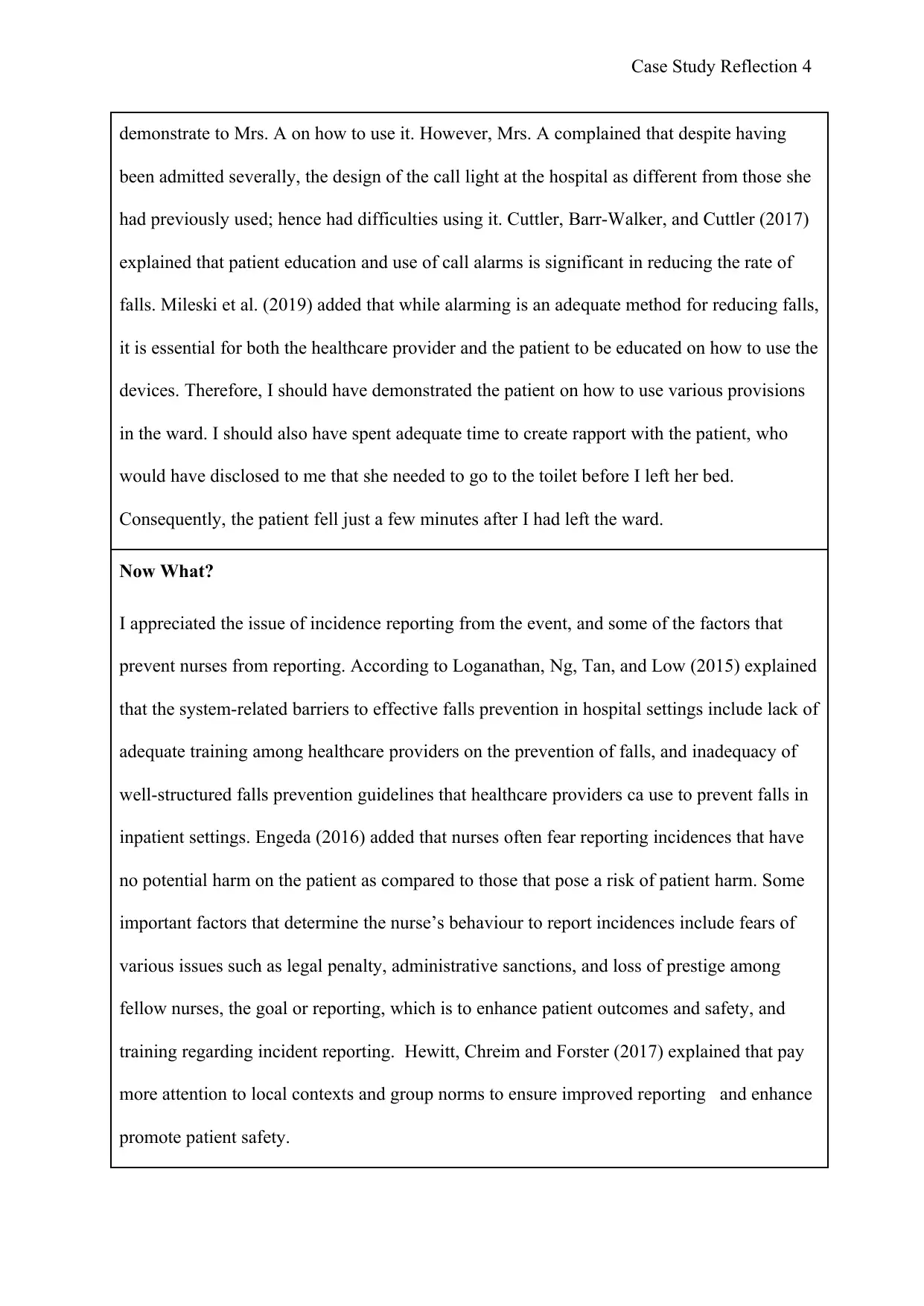
Case Study Reflection 4
demonstrate to Mrs. A on how to use it. However, Mrs. A complained that despite having
been admitted severally, the design of the call light at the hospital as different from those she
had previously used; hence had difficulties using it. Cuttler, Barr-Walker, and Cuttler (2017)
explained that patient education and use of call alarms is significant in reducing the rate of
falls. Mileski et al. (2019) added that while alarming is an adequate method for reducing falls,
it is essential for both the healthcare provider and the patient to be educated on how to use the
devices. Therefore, I should have demonstrated the patient on how to use various provisions
in the ward. I should also have spent adequate time to create rapport with the patient, who
would have disclosed to me that she needed to go to the toilet before I left her bed.
Consequently, the patient fell just a few minutes after I had left the ward.
Now What?
I appreciated the issue of incidence reporting from the event, and some of the factors that
prevent nurses from reporting. According to Loganathan, Ng, Tan, and Low (2015) explained
that the system-related barriers to effective falls prevention in hospital settings include lack of
adequate training among healthcare providers on the prevention of falls, and inadequacy of
well-structured falls prevention guidelines that healthcare providers ca use to prevent falls in
inpatient settings. Engeda (2016) added that nurses often fear reporting incidences that have
no potential harm on the patient as compared to those that pose a risk of patient harm. Some
important factors that determine the nurse’s behaviour to report incidences include fears of
various issues such as legal penalty, administrative sanctions, and loss of prestige among
fellow nurses, the goal or reporting, which is to enhance patient outcomes and safety, and
training regarding incident reporting. Hewitt, Chreim and Forster (2017) explained that pay
more attention to local contexts and group norms to ensure improved reporting and enhance
promote patient safety.
demonstrate to Mrs. A on how to use it. However, Mrs. A complained that despite having
been admitted severally, the design of the call light at the hospital as different from those she
had previously used; hence had difficulties using it. Cuttler, Barr-Walker, and Cuttler (2017)
explained that patient education and use of call alarms is significant in reducing the rate of
falls. Mileski et al. (2019) added that while alarming is an adequate method for reducing falls,
it is essential for both the healthcare provider and the patient to be educated on how to use the
devices. Therefore, I should have demonstrated the patient on how to use various provisions
in the ward. I should also have spent adequate time to create rapport with the patient, who
would have disclosed to me that she needed to go to the toilet before I left her bed.
Consequently, the patient fell just a few minutes after I had left the ward.
Now What?
I appreciated the issue of incidence reporting from the event, and some of the factors that
prevent nurses from reporting. According to Loganathan, Ng, Tan, and Low (2015) explained
that the system-related barriers to effective falls prevention in hospital settings include lack of
adequate training among healthcare providers on the prevention of falls, and inadequacy of
well-structured falls prevention guidelines that healthcare providers ca use to prevent falls in
inpatient settings. Engeda (2016) added that nurses often fear reporting incidences that have
no potential harm on the patient as compared to those that pose a risk of patient harm. Some
important factors that determine the nurse’s behaviour to report incidences include fears of
various issues such as legal penalty, administrative sanctions, and loss of prestige among
fellow nurses, the goal or reporting, which is to enhance patient outcomes and safety, and
training regarding incident reporting. Hewitt, Chreim and Forster (2017) explained that pay
more attention to local contexts and group norms to ensure improved reporting and enhance
promote patient safety.
Paraphrase This Document
Need a fresh take? Get an instant paraphrase of this document with our AI Paraphraser
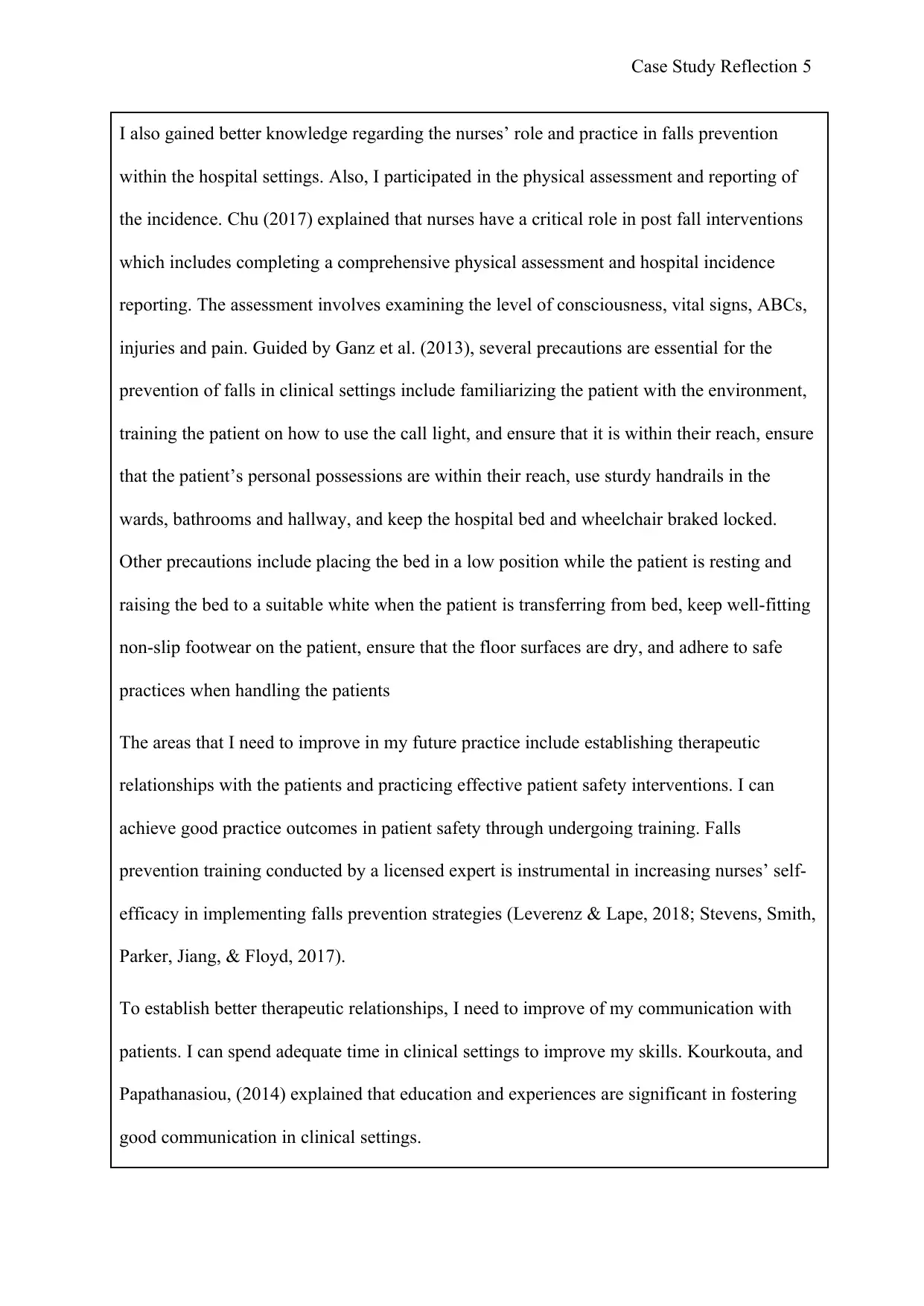
Case Study Reflection 5
I also gained better knowledge regarding the nurses’ role and practice in falls prevention
within the hospital settings. Also, I participated in the physical assessment and reporting of
the incidence. Chu (2017) explained that nurses have a critical role in post fall interventions
which includes completing a comprehensive physical assessment and hospital incidence
reporting. The assessment involves examining the level of consciousness, vital signs, ABCs,
injuries and pain. Guided by Ganz et al. (2013), several precautions are essential for the
prevention of falls in clinical settings include familiarizing the patient with the environment,
training the patient on how to use the call light, and ensure that it is within their reach, ensure
that the patient’s personal possessions are within their reach, use sturdy handrails in the
wards, bathrooms and hallway, and keep the hospital bed and wheelchair braked locked.
Other precautions include placing the bed in a low position while the patient is resting and
raising the bed to a suitable white when the patient is transferring from bed, keep well-fitting
non-slip footwear on the patient, ensure that the floor surfaces are dry, and adhere to safe
practices when handling the patients
The areas that I need to improve in my future practice include establishing therapeutic
relationships with the patients and practicing effective patient safety interventions. I can
achieve good practice outcomes in patient safety through undergoing training. Falls
prevention training conducted by a licensed expert is instrumental in increasing nurses’ self-
efficacy in implementing falls prevention strategies (Leverenz & Lape, 2018; Stevens, Smith,
Parker, Jiang, & Floyd, 2017).
To establish better therapeutic relationships, I need to improve of my communication with
patients. I can spend adequate time in clinical settings to improve my skills. Kourkouta, and
Papathanasiou, (2014) explained that education and experiences are significant in fostering
good communication in clinical settings.
I also gained better knowledge regarding the nurses’ role and practice in falls prevention
within the hospital settings. Also, I participated in the physical assessment and reporting of
the incidence. Chu (2017) explained that nurses have a critical role in post fall interventions
which includes completing a comprehensive physical assessment and hospital incidence
reporting. The assessment involves examining the level of consciousness, vital signs, ABCs,
injuries and pain. Guided by Ganz et al. (2013), several precautions are essential for the
prevention of falls in clinical settings include familiarizing the patient with the environment,
training the patient on how to use the call light, and ensure that it is within their reach, ensure
that the patient’s personal possessions are within their reach, use sturdy handrails in the
wards, bathrooms and hallway, and keep the hospital bed and wheelchair braked locked.
Other precautions include placing the bed in a low position while the patient is resting and
raising the bed to a suitable white when the patient is transferring from bed, keep well-fitting
non-slip footwear on the patient, ensure that the floor surfaces are dry, and adhere to safe
practices when handling the patients
The areas that I need to improve in my future practice include establishing therapeutic
relationships with the patients and practicing effective patient safety interventions. I can
achieve good practice outcomes in patient safety through undergoing training. Falls
prevention training conducted by a licensed expert is instrumental in increasing nurses’ self-
efficacy in implementing falls prevention strategies (Leverenz & Lape, 2018; Stevens, Smith,
Parker, Jiang, & Floyd, 2017).
To establish better therapeutic relationships, I need to improve of my communication with
patients. I can spend adequate time in clinical settings to improve my skills. Kourkouta, and
Papathanasiou, (2014) explained that education and experiences are significant in fostering
good communication in clinical settings.
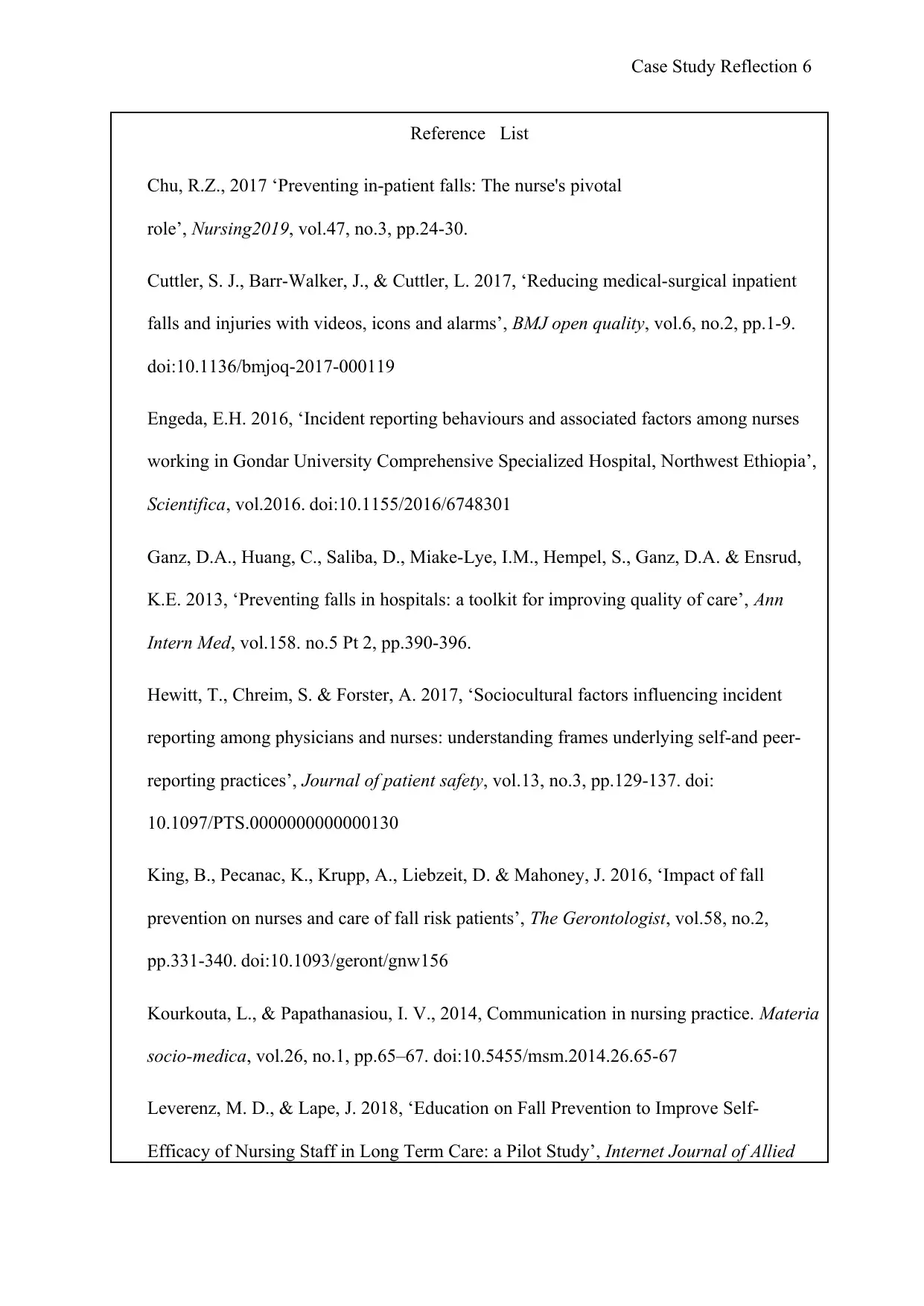
Case Study Reflection 6
Reference List
Chu, R.Z., 2017 ‘Preventing in-patient falls: The nurse's pivotal
role’, Nursing2019, vol.47, no.3, pp.24-30.
Cuttler, S. J., Barr-Walker, J., & Cuttler, L. 2017, ‘Reducing medical-surgical inpatient
falls and injuries with videos, icons and alarms’, BMJ open quality, vol.6, no.2, pp.1-9.
doi:10.1136/bmjoq-2017-000119
Engeda, E.H. 2016, ‘Incident reporting behaviours and associated factors among nurses
working in Gondar University Comprehensive Specialized Hospital, Northwest Ethiopia’,
Scientifica, vol.2016. doi:10.1155/2016/6748301
Ganz, D.A., Huang, C., Saliba, D., Miake-Lye, I.M., Hempel, S., Ganz, D.A. & Ensrud,
K.E. 2013, ‘Preventing falls in hospitals: a toolkit for improving quality of care’, Ann
Intern Med, vol.158. no.5 Pt 2, pp.390-396.
Hewitt, T., Chreim, S. & Forster, A. 2017, ‘Sociocultural factors influencing incident
reporting among physicians and nurses: understanding frames underlying self-and peer-
reporting practices’, Journal of patient safety, vol.13, no.3, pp.129-137. doi:
10.1097/PTS.0000000000000130
King, B., Pecanac, K., Krupp, A., Liebzeit, D. & Mahoney, J. 2016, ‘Impact of fall
prevention on nurses and care of fall risk patients’, The Gerontologist, vol.58, no.2,
pp.331-340. doi:10.1093/geront/gnw156
Kourkouta, L., & Papathanasiou, I. V., 2014, Communication in nursing practice. Materia
socio-medica, vol.26, no.1, pp.65–67. doi:10.5455/msm.2014.26.65-67
Leverenz, M. D., & Lape, J. 2018, ‘Education on Fall Prevention to Improve Self-
Efficacy of Nursing Staff in Long Term Care: a Pilot Study’, Internet Journal of Allied
Reference List
Chu, R.Z., 2017 ‘Preventing in-patient falls: The nurse's pivotal
role’, Nursing2019, vol.47, no.3, pp.24-30.
Cuttler, S. J., Barr-Walker, J., & Cuttler, L. 2017, ‘Reducing medical-surgical inpatient
falls and injuries with videos, icons and alarms’, BMJ open quality, vol.6, no.2, pp.1-9.
doi:10.1136/bmjoq-2017-000119
Engeda, E.H. 2016, ‘Incident reporting behaviours and associated factors among nurses
working in Gondar University Comprehensive Specialized Hospital, Northwest Ethiopia’,
Scientifica, vol.2016. doi:10.1155/2016/6748301
Ganz, D.A., Huang, C., Saliba, D., Miake-Lye, I.M., Hempel, S., Ganz, D.A. & Ensrud,
K.E. 2013, ‘Preventing falls in hospitals: a toolkit for improving quality of care’, Ann
Intern Med, vol.158. no.5 Pt 2, pp.390-396.
Hewitt, T., Chreim, S. & Forster, A. 2017, ‘Sociocultural factors influencing incident
reporting among physicians and nurses: understanding frames underlying self-and peer-
reporting practices’, Journal of patient safety, vol.13, no.3, pp.129-137. doi:
10.1097/PTS.0000000000000130
King, B., Pecanac, K., Krupp, A., Liebzeit, D. & Mahoney, J. 2016, ‘Impact of fall
prevention on nurses and care of fall risk patients’, The Gerontologist, vol.58, no.2,
pp.331-340. doi:10.1093/geront/gnw156
Kourkouta, L., & Papathanasiou, I. V., 2014, Communication in nursing practice. Materia
socio-medica, vol.26, no.1, pp.65–67. doi:10.5455/msm.2014.26.65-67
Leverenz, M. D., & Lape, J. 2018, ‘Education on Fall Prevention to Improve Self-
Efficacy of Nursing Staff in Long Term Care: a Pilot Study’, Internet Journal of Allied
⊘ This is a preview!⊘
Do you want full access?
Subscribe today to unlock all pages.

Trusted by 1+ million students worldwide
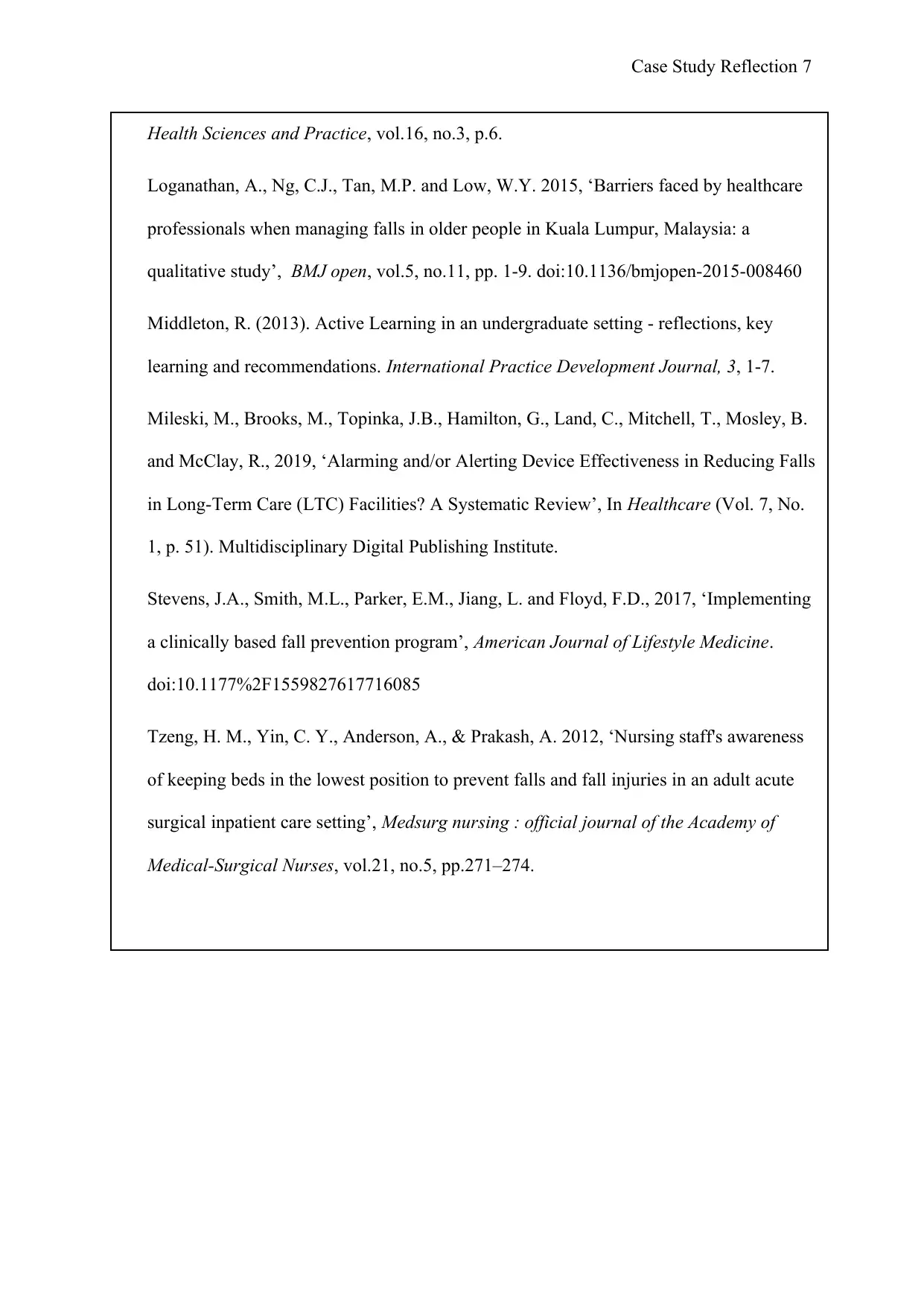
Case Study Reflection 7
Health Sciences and Practice, vol.16, no.3, p.6.
Loganathan, A., Ng, C.J., Tan, M.P. and Low, W.Y. 2015, ‘Barriers faced by healthcare
professionals when managing falls in older people in Kuala Lumpur, Malaysia: a
qualitative study’, BMJ open, vol.5, no.11, pp. 1-9. doi:10.1136/bmjopen-2015-008460
Middleton, R. (2013). Active Learning in an undergraduate setting - reflections, key
learning and recommendations. International Practice Development Journal, 3, 1-7.
Mileski, M., Brooks, M., Topinka, J.B., Hamilton, G., Land, C., Mitchell, T., Mosley, B.
and McClay, R., 2019, ‘Alarming and/or Alerting Device Effectiveness in Reducing Falls
in Long-Term Care (LTC) Facilities? A Systematic Review’, In Healthcare (Vol. 7, No.
1, p. 51). Multidisciplinary Digital Publishing Institute.
Stevens, J.A., Smith, M.L., Parker, E.M., Jiang, L. and Floyd, F.D., 2017, ‘Implementing
a clinically based fall prevention program’, American Journal of Lifestyle Medicine.
doi:10.1177%2F1559827617716085
Tzeng, H. M., Yin, C. Y., Anderson, A., & Prakash, A. 2012, ‘Nursing staff's awareness
of keeping beds in the lowest position to prevent falls and fall injuries in an adult acute
surgical inpatient care setting’, Medsurg nursing : official journal of the Academy of
Medical-Surgical Nurses, vol.21, no.5, pp.271–274.
Health Sciences and Practice, vol.16, no.3, p.6.
Loganathan, A., Ng, C.J., Tan, M.P. and Low, W.Y. 2015, ‘Barriers faced by healthcare
professionals when managing falls in older people in Kuala Lumpur, Malaysia: a
qualitative study’, BMJ open, vol.5, no.11, pp. 1-9. doi:10.1136/bmjopen-2015-008460
Middleton, R. (2013). Active Learning in an undergraduate setting - reflections, key
learning and recommendations. International Practice Development Journal, 3, 1-7.
Mileski, M., Brooks, M., Topinka, J.B., Hamilton, G., Land, C., Mitchell, T., Mosley, B.
and McClay, R., 2019, ‘Alarming and/or Alerting Device Effectiveness in Reducing Falls
in Long-Term Care (LTC) Facilities? A Systematic Review’, In Healthcare (Vol. 7, No.
1, p. 51). Multidisciplinary Digital Publishing Institute.
Stevens, J.A., Smith, M.L., Parker, E.M., Jiang, L. and Floyd, F.D., 2017, ‘Implementing
a clinically based fall prevention program’, American Journal of Lifestyle Medicine.
doi:10.1177%2F1559827617716085
Tzeng, H. M., Yin, C. Y., Anderson, A., & Prakash, A. 2012, ‘Nursing staff's awareness
of keeping beds in the lowest position to prevent falls and fall injuries in an adult acute
surgical inpatient care setting’, Medsurg nursing : official journal of the Academy of
Medical-Surgical Nurses, vol.21, no.5, pp.271–274.
1 out of 7
Related Documents
Your All-in-One AI-Powered Toolkit for Academic Success.
+13062052269
info@desklib.com
Available 24*7 on WhatsApp / Email
![[object Object]](/_next/static/media/star-bottom.7253800d.svg)
Unlock your academic potential
Copyright © 2020–2025 A2Z Services. All Rights Reserved. Developed and managed by ZUCOL.





